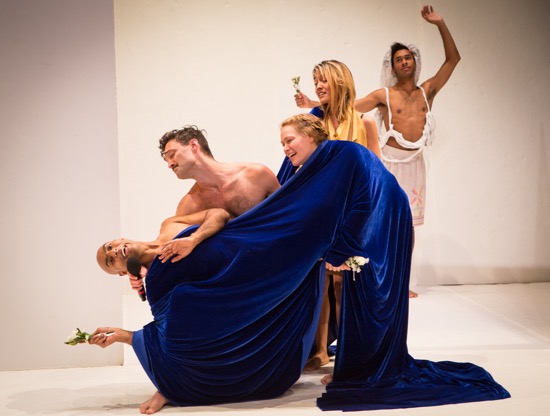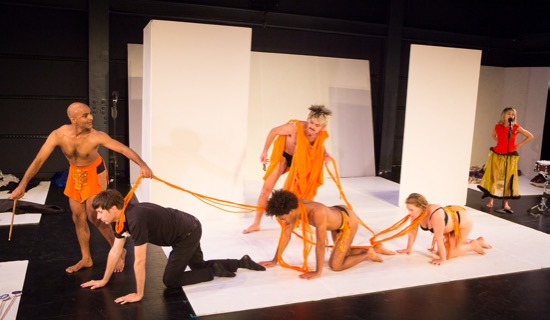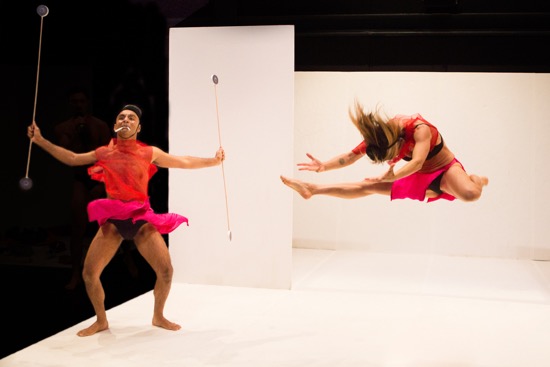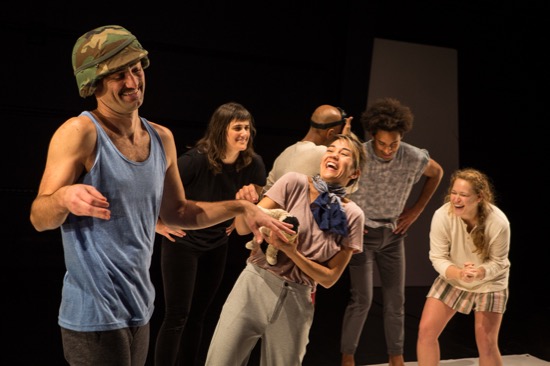Faye Driscoll presents Thank You for Coming; Play at BAM Fisher.

The birth of a hero. (L to R): Paul Singh, Sean Donovan, Laurel Snyder, Alicia Ohs, and Brandon Washington in Faye Driscoll’s Thank You for Coming: Play. Photo: Yi-Chun Wu
I could swear that Faye Driscoll has done something to her eyebrows. They seem to slant downward the way they would if she were an Indian dancer portraying one of the nine permanent emotions: “karuna” (compassion or “the pathetic”). Even though the guy I’m sitting next to in BAM Fisher’s front row laughs boisterously at the goings-on in her Thank You for Coming: Play, I often see her as sad—certainly when she enters with a small birthday cake, and no one onstage notices it, but also when far larger issues are being booted around.
Thank You for Coming: Play is the second part of a projected trilogy; the first part, Thank You for Coming: Attendance, was performed at Danspace St. Mark’s in 2014. As with the earlier work, there’s planned interaction between the performers and the spectators (I’ve been asked to keep it a surprise), but far less of it and, in the end, that connection makes a powerful point.
Somewhere online I found this statement by Driscoll about the new work: it “focuses on the way we consume and fabricate stories in order to make our lives cohere.” In this wild and witty and terrifying piece, coherence becomes perilously incoherent. What’s happening here?? It’s best not to worry, just to watch. Imagine if years of confusions, missteps, and lies in your own life had been condensed into 75 splitting-at-the-seams minutes.
It takes fastidious organization to create this kind of chaos. From four blankets—two on each side of the space—the six performers (all collaborators in the making of the piece) are almost constantly grabbing, donning, removing, and discarding garments and accessories. Most of these are fancy: silk, velvet, metallic, transparent—used in strange ways and whipped into place over black jockstraps, plus black bras for the women. Driscoll herself moves the white panels that constitute the set (by Nick Vaughan and Jake Margolin) and helps adjust garments, but also gets sucked into the action.

Paul Singh herding (L to R): Bobby McElver, Brandon Washington, and Laurel Snyder. Presiding: Sean Donovan. Far right: at mic: Alicia Ohs. Photo: Yi-Chun Wu
The fantastically talented others (Sean Donovan, Alicia Ohs, Paul Singh, Laurel Snyder, and Brandon Washington)—who sing, dance, and act with immense conviction—sometimes function as “themselves.” For instance, at one point, Ohs has gotten composer-musican Bobby McElver down and is kneeling on him, screaming at him, while Donovan, at a microphone, is urging us to join in chanting “FUCK HIM UP!” But the next minute, he addresses his colleagues in his everyday voice, saying something like, “Guys, if we can’t get along in the theater, how will we get through. . .?” Seconds later, McElver, Washington, and Snyder are yoked together by orange ropes, plodding along on their hands and knees, with Singh as herder, when the message becomes “Free the cows!” Once they’re freed, this call rings out: “We are Barbone (sp.?)!” “We are free.”
Any one of the performers can be Barbone (baboon?), the ill-fated superhero whose story they’re purporting to tell via deliberately exaggerated facial expressions, stances, and vocal theatrics. They yell, sing, fight, fuck, give birth (you get the impression that if they could do all these things at once, they would). Oh, and they not only sing music McElver, Donovan, or Driscoll, they play instruments. At one point, some of them join McElver at his equipment; look left, and you see Ohs hitting a drum, Washington attacking the cymbals, Donovan managing a keyboard, and Singh playing his clarinet.

Paul Singh and (leaping) Alicia Ohs in one of their disguises in Thank You for Coming: Play. Photo: Yi-Chun Wu
Around the half-way point of the piece, Driscoll goes to a microphone and delivers a fevered rant, opening her mouth very wide with every vowel, biting down on the consonants. I’m sitting only a couple of yards away from her; nevertheless, amid the musical craziness noted above, I can’t make out all the words or be sure whether she’s impersonating someone, condemning him, or both. You can probably guess who that someone is: I hear words re disbelief in climate change and plans to “make America great again” and “I’m gonna be big!” By the time Driscoll has broken into breathless sobs, most of the others have collapsed in a heap. At this moment, Donovan enters with pigtails and (if memory serves) wearing a print dress, to give an order in a high, ladylike voice: “Will you stop making that noise!” In response to which, Driscoll assumes her choreographer-persona and says reprovingly that, “Any comment should come from me.” And, wait, is Barbone now dead (Snyder appears to be)? Or has he/she just left? Oh no! Why did he leave? And Ohs performs a magnificently extravagant dance of despair.
The wedding of Barbone’s parents (Washington in bridal attire, Donovan as the doddering groom) comes some time after the birth scene, which involves Singh (the infant) being held upside down behind a blue velvet cloth, while almost everyone else hovers. Is Snyder now the mother? (Don’t worry about it; isn’t it enough that she cares?)

Faye Driscoll’s Thank You for Coming: Play. Foreground: Sean Donovan (L) and Alicia Ohs. At back (L to R): Faye Driscoll, Paul Singh, Brandon Washington, and Laurel Snyder. Photo: Yi-Chun Wu
The last part of the piece moves into new zone. The dancers have gradually garbed themselves in practice clothes or casual attire; now they drink water and talk about how they feel. Vulnerable, yes. Donovan struggles to get out “lonely.” Yes, they all nod. They discuss, awkwardly, what community means to them but what an effort it takes to be social. Beginning thus, with laughter and hugs, they begin to adopt more exaggerated behavior—all of it within a fairly circumscribed space (the lighting by Amanda K. Ringger contributes to the transformations.
What most fascinating in this long final sequence is the unsettling displacement between what they think, feel, say, and show. As they move into exaggerated poses vis-à-vis one another, they communicate in spoken phrases interspersed with silent mouthing. It takes me a while to realize that they are repeating the same sequence of complex interactions over and over, the movements often mating differently with the heard or unheard words (which may reflect opposing attitudes). I’m clued in by the fact that McElver keeps leaving the sound equipment to join the group and then going back to his place on the side, as well as mouthing a reply to the questions they direct to him. Then, of course, I can notice that Donovan has a hurling gesture, and that Singh frequently faces in one direction, hunkers down a bit, and opens his mouth wide (only after the sequence has occurred several times, does he say aloud the words that synch with the pose). One strong repeated moment: they all turn, look at us, and react—maybe seeming to ask a question, maybe rearing back in disgust or fear.
Other themes recur (the loneliness issue, say), and they attempt a party atmosphere with little conical hats and a pathetic sprinkle of confetti from Driscoll. We see viciousness, hear silence. But as they prolong wildness, she begins to move the white panels into place, confining the cast within a white box. She stands in its one narrow opening, reading furiously from one index card after another, tossing each to the floor. Each phrase she calls out begins with “Oh,” and each continues with a two or more words of extreme emotion and an implied exclamation point. She rocks with the effort of this exalting or grieving; she hardly has time to breathe. And then it’s over, and the audience rises to its feet.
I could say that the final repeating sequence goes on for what seems a very long time, but considering how long it took me to “get it,” the number of repetitions may have been necessary.
I could (will) also say that I still know almost nothing about “Barbone.” He could be any gender, was born, lived, died, and maybe came back to life. I know nothing of what he accomplished or didn’t, who loved him and who feared him. Perhaps the confusion was deliberate on the part of Driscoll and her colleagues. Perhaps Barbone was a dissembler, a shape shifter—a hero to some, a villain to others, a god only to himself.
